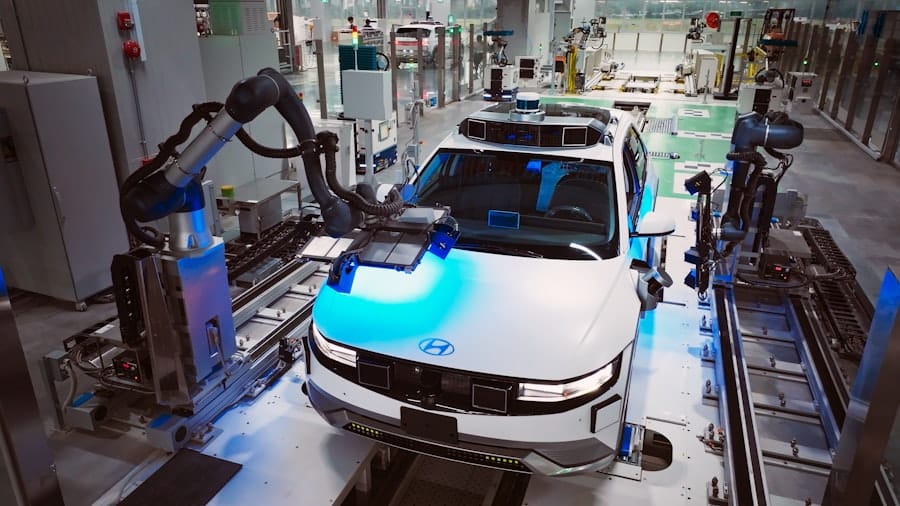The integration of robotics into rehabilitation therapy represents a significant advancement in the field of medical technology, offering new avenues for patient recovery and rehabilitation. As the global population ages and the prevalence of chronic conditions increases, the demand for effective rehabilitation solutions has never been more pressing. Robotics in rehabilitation therapy encompasses a range of technologies designed to assist patients in regaining mobility, strength, and functionality after injury or illness.
This innovative approach not only enhances traditional therapeutic methods but also introduces a level of precision and consistency that is often unattainable through human intervention alone. Robotic systems can be tailored to meet the specific needs of individual patients, providing personalized therapy that adapts to their progress.
The evolution of robotics in this domain has been fueled by advancements in artificial intelligence, machine learning, and sensor technology, allowing for more sophisticated interactions between machines and patients. As we delve deeper into the role of robotics in rehabilitation therapy, it becomes evident that these technologies are not merely tools but transformative agents that can redefine recovery processes.
Key Takeaways
- Robotics enhances precision and effectiveness in physical rehabilitation therapy.
- Various robotic devices assist in different types of rehabilitation exercises.
- Robotics offers benefits like increased patient motivation and consistent therapy sessions.
- Challenges include high costs and the need for specialized training.
- Future innovations promise more personalized and adaptive rehabilitation solutions.
The Role of Robotics in Physical Rehabilitation
Robotics plays a multifaceted role in physical rehabilitation, serving as both a facilitator of movement and a source of motivation for patients. One of the primary functions of robotic systems is to provide assistance during physical therapy exercises, enabling patients to perform movements that they may struggle with due to injury or disability. For instance, robotic exoskeletons can support the weight of a patient’s body while allowing them to practice walking, thereby reducing the risk of falls and promoting confidence in their abilities.
This support is particularly beneficial for individuals recovering from strokes or spinal cord injuries, where regaining mobility is a critical aspect of rehabilitation. Moreover, robotics can enhance the efficiency and effectiveness of rehabilitation programs by offering real-time feedback and data collection. Advanced robotic systems are equipped with sensors that monitor a patient’s movements, providing therapists with valuable insights into their progress.
This data-driven approach allows for the customization of therapy sessions based on individual performance metrics, ensuring that patients receive the appropriate level of challenge and support. Additionally, the repetitive nature of robotic-assisted exercises can lead to improved motor learning and neuroplasticity, which are essential for recovery. By engaging patients in a structured yet adaptable manner, robotics fosters an environment conducive to healing and growth.
Benefits of Using Robotics in Rehabilitation Therapy

The benefits of incorporating robotics into rehabilitation therapy are manifold, extending beyond mere physical improvements to encompass psychological and emotional dimensions as well. One significant advantage is the ability to deliver consistent and repeatable therapy sessions.
This consistency is crucial for building muscle memory and reinforcing proper techniques, which are vital for long-term recovery. Furthermore, robotics can enhance patient engagement and motivation during therapy sessions. Many robotic systems incorporate gamification elements, transforming monotonous exercises into interactive challenges that encourage participation.
For example, patients may use virtual reality environments where they control robotic limbs to complete tasks or navigate obstacles. This immersive experience not only makes therapy more enjoyable but also promotes adherence to rehabilitation programs. The psychological benefits of increased motivation and enjoyment can lead to improved outcomes, as patients are more likely to invest effort into their recovery when they find the process engaging.
Types of Robotics Used in Rehabilitation Therapy
A diverse array of robotic technologies is employed in rehabilitation therapy, each designed to address specific needs and challenges faced by patients. One prominent category is robotic exoskeletons, which are wearable devices that assist individuals with mobility impairments. These exoskeletons can be used for gait training in patients recovering from strokes or spinal cord injuries, allowing them to practice walking with support while minimizing the risk of injury.
Companies like Ekso Bionics and ReWalk Robotics have developed exoskeletons that have been successfully implemented in clinical settings, demonstrating their effectiveness in improving mobility. Another important type of robotic technology is robotic arms and manipulators used for upper limb rehabilitation. These devices assist patients in performing repetitive tasks that are essential for regaining fine motor skills and strength.
For instance, the Armeo system by Hocoma provides a robotic arm that supports the weight of a patient’s arm while they engage in various exercises designed to improve hand function. Such systems often incorporate feedback mechanisms that guide patients through movements, ensuring they are performing exercises correctly and effectively.
Examples of Successful Rehabilitation Therapy Using Robotics
Numerous case studies illustrate the successful application of robotics in rehabilitation therapy across various patient populations. One notable example is the use of robotic exoskeletons in stroke rehabilitation. A study published in the journal “Stroke” highlighted the positive outcomes associated with using the Ekso GT exoskeleton for gait training in stroke survivors.
Participants who engaged in robotic-assisted walking showed significant improvements in their ability to walk independently compared to those who received conventional therapy alone. This evidence underscores the potential of robotics to enhance functional recovery after neurological events. In pediatric rehabilitation, robotic systems have also demonstrated remarkable success.
The use of the MIT-Manus robotic arm has been shown to improve motor function in children with cerebral palsy. In clinical trials, children who participated in therapy sessions with the MIT-Manus exhibited greater improvements in upper limb function than those who received standard care. These examples not only highlight the efficacy of robotics in diverse patient populations but also emphasize the adaptability of these technologies to meet varying therapeutic needs.
Challenges and Limitations of Robotics in Rehabilitation Therapy

Despite the promising advancements in robotics for rehabilitation therapy, several challenges and limitations persist that must be addressed to maximize their potential impact. One significant hurdle is the high cost associated with developing and implementing robotic systems. Many advanced robotic devices require substantial financial investment for both acquisition and maintenance, which can limit accessibility for healthcare facilities, particularly those operating on tight budgets or in underserved areas.
This economic barrier can hinder widespread adoption and restrict patient access to cutting-edge rehabilitation technologies. Additionally, there are technical challenges related to the integration of robotics into existing therapeutic frameworks. Effective collaboration between robotic systems and human therapists is essential for optimizing patient outcomes; however, this requires training and adaptation on both sides.
Therapists must become proficient in using these technologies while also maintaining their therapeutic skills. Furthermore, there may be resistance from some healthcare professionals who are skeptical about replacing traditional methods with robotic interventions. Overcoming these challenges necessitates ongoing education and research to demonstrate the efficacy and value of robotics in rehabilitation therapy.
Future Developments and Innovations in Robotics for Rehabilitation Therapy
The future of robotics in rehabilitation therapy holds immense promise as technological advancements continue to evolve at a rapid pace. One area poised for significant growth is the integration of artificial intelligence (AI) into robotic systems. AI can enhance the adaptability of robots by enabling them to learn from patient interactions and adjust therapy protocols accordingly.
This personalized approach could lead to more effective rehabilitation strategies tailored to individual progress and needs. Moreover, advancements in soft robotics may revolutionize how rehabilitation devices interact with patients. Soft robots are designed with flexible materials that mimic human muscles and tendons, allowing for more natural movements during therapy sessions.
This technology could improve comfort and reduce the risk of injury during rehabilitation exercises. Additionally, innovations such as tele-rehabilitation—where patients engage with robotic systems remotely—could expand access to therapy for individuals living in remote areas or those unable to attend traditional therapy sessions due to mobility constraints.
The Impact of Robotics on the Future of Rehabilitation Therapy
The impact of robotics on rehabilitation therapy is profound and far-reaching, shaping not only how therapies are delivered but also how patients experience recovery. As we continue to explore the capabilities of robotic systems, it becomes increasingly clear that these technologies have the potential to transform rehabilitation practices fundamentally. By enhancing mobility, providing personalized feedback, and fostering patient engagement, robotics can significantly improve outcomes for individuals recovering from injuries or disabilities.
As we look ahead, it is essential to address existing challenges while embracing innovations that will further integrate robotics into rehabilitation therapy. The collaboration between engineers, healthcare professionals, and researchers will be crucial in developing solutions that maximize the benefits of these technologies while ensuring accessibility for all patients. Ultimately, the future of rehabilitation therapy lies at the intersection of human expertise and robotic precision—a partnership that promises to redefine recovery pathways for countless individuals around the world.
Robotics have become an integral part of rehabilitation therapy, enhancing the recovery process for patients with various physical impairments. For those interested in exploring how technology can further improve health and wellness, a related article on the best smartwatch apps of 2023 can provide insights into how wearable technology complements rehabilitation efforts. You can read more about it in this article.
FAQs
What is robotics in rehabilitation therapy?
Robotics in rehabilitation therapy refers to the use of robotic devices and technology to assist patients in recovering physical functions, such as movement and strength, after injury or illness.
How do robotic devices support rehabilitation therapy?
Robotic devices provide consistent, repetitive, and precise movements that help patients perform therapeutic exercises, enhance motor learning, and improve recovery outcomes.
What types of rehabilitation therapies use robotics?
Robotics are commonly used in physical therapy, occupational therapy, and neurorehabilitation to aid recovery from conditions like stroke, spinal cord injury, and musculoskeletal disorders.
Are robotic rehabilitation therapies suitable for all patients?
While many patients can benefit, suitability depends on individual conditions, severity of impairment, and medical advice. Therapists assess each patient to determine if robotic therapy is appropriate.
What are the benefits of using robotics in rehabilitation?
Benefits include increased therapy intensity and duration, improved patient motivation, objective progress tracking, and the ability to tailor exercises to individual needs.
Can robotics replace traditional rehabilitation therapy?
Robotics are generally used as a complement to traditional therapy, enhancing but not fully replacing the role of human therapists in rehabilitation.
Is robotic rehabilitation therapy safe?
Yes, robotic rehabilitation devices are designed with safety features and are used under professional supervision to ensure patient safety during therapy sessions.
How effective is robotics in improving rehabilitation outcomes?
Research shows that robotic-assisted therapy can improve motor function, speed up recovery, and increase patient engagement, especially when combined with conventional therapy methods.
What types of robotic devices are used in rehabilitation?
Common devices include exoskeletons, robotic arms, gait trainers, and virtual reality systems that assist with movement and provide feedback during therapy.
How accessible is robotic rehabilitation therapy?
Accessibility varies by region and healthcare facility, with some advanced robotic therapies available primarily in specialized centers due to cost and equipment requirements.

